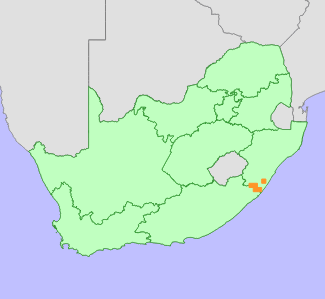|
Scientific Name | Asclepias schlechteri (K.Schum.) N.E.Br. |
Higher Classification | Dicotyledons |
Family | APOCYNACEAE |
Synonyms | Gomphocarpus schlechteri K.Schum. |
National Status |
Status and Criteria | Endangered B2ab(ii,iii,iv,v) |
Assessment Date | 2007/08/07 |
Assessor(s) | A. Nicholas & L. von Staden |
Justification | Although this species is very poorly known, there is good reason to believe that it is rare and declining as a result of habitat destruction through afforestation, agriculture and overgrazing. It is currently known from one location, but was collected from up to six historical locations. Although it has a large EOO (7500-37 500 km²), the species is extremely rare within its range and its area of occupancy is probably very low (estimated <250 km²). Subpopulations are isolated and severely fragmented due to habitat destruction. |
Distribution |
Endemism | South African endemic |
Provincial distribution | Eastern Cape, KwaZulu-Natal |
Range | Harding and surrounding areas on the border between KwaZulu-Natal and the Eastern Cape, possibly also in Swaziland. |
Habitat and Ecology |
Major system | Terrestrial |
Major habitats | Moist Coast Hinterland Grassland, Dry Coast Hinterland Grassland, Pondoland-Ugu Sandstone Coastal Sourveld |
Description | Ngongoni Veld, sandy soils in tall grasslands. |
Threats |
| The habitat of this species in KwaZulu-Natal is extensively transformed by commercial forestry plantations, agriculture (crop fields) and dairy farming - which converts natural grasslands to pasture (Nicholas 1999). One historical locality is thought to be locally extinct due to habitat transformation (Scott-Shaw 1999). Localities in southern KwaZulu-Natal/northern Eastern Cape border area are in areas of dense rural settlements, which means that grasslands are also probably severely degraded by overgrazing of communal rangelands.
Ngongoni Veld within the known historical range of this species (Kenterton to Lusikisiki) is 54% transformed and Mistbelt Grasslands are 66% transformed (calculated using GIS). Ngongoni Veld has been classified as Vulnerable and Mistbelt Grasslands as Endangered (Rouget et al. 2004), indicating that these vegetation types are highly transformed and poorly protected. |
Population |
This species is extremely rare, and repeated searches even in undisturbed habitats have failed to record more subpopulations. It is currently known from a very small area, but some older collections indicate a wider distribution between the Eastern Cape and Swaziland. It may be that this species is a formerly more widespread palaeoendemic now surviving in very small, isolated subpopulations, but more study is needed to confirm this (A. Nicholas pers. comm.).
|
Population trend | Decreasing |
Conservation |
| No records from formally conserved areas are known. |
Assessment History |
Taxon assessed |
Status and Criteria |
Citation/Red List version | | Asclepias schlechteri (K.Schum.) N.E.Br. | EN B2ab(ii,iii,iv,v) | Raimondo et al. (2009) | | Asclepias schlechteri (K.Schum.) N.E.Br. | EN B1B2c,D1 | Scott-Shaw (1999) | | Asclepias schlechteri (K.Schum.) N.E.Br. | Endangered | Hilton-Taylor (1996) | |
Bibliography |
Hilton-Taylor, C. 1996. Red data list of southern African plants. Strelitzia 4. South African National Botanical Institute, Pretoria.
Mucina, L. and Rutherford, M.C. (eds). 2006. The vegetation of South Africa, Lesotho and Swaziland. Strelitzia 19. South African National Biodiversity Institute, Pretoria.
Nicholas, A. 1982. Taxonomic studies in Asclepias (Asclepiadeae) with particular reference to the narrow-leaved species in southern Africa. University of Natal.
Nicholas, A. 1999. A taxonomic reassessment of the subtribe Asclepiadinae (Asclepiaceae) in Southern Africa. Unpublished Ph.D., University of Durban-Westville, Durban.
Raimondo, D., von Staden, L., Foden, W., Victor, J.E., Helme, N.A., Turner, R.C., Kamundi, D.A. and Manyama, P.A. 2009. Red List of South African Plants. Strelitzia 25. South African National Biodiversity Institute, Pretoria.
Rouget, M., Reyers, B., Jonas, Z., Desmet, P., Driver, A., Maze, K., Egoh, B. and Cowling, R.M. 2004. South African National Spatial Biodiversity Assessment 2004: Technical Report. Volume 1: Terrestrial component. South African National Biodiversity Institute, Pretoria.
Schuman, K.M. 1904. Gomphocarpus schlechteri. Botanische Jahrbücher für Systematik 33:235.
Scott-Shaw, C.R. 1999. Rare and threatened plants of KwaZulu-Natal and neighbouring regions. KwaZulu-Natal Nature Conservation Service, Pietermaritzburg.
|
Citation |
| Nicholas, A. & von Staden, L. 2007. Asclepias schlechteri (K.Schum.) N.E.Br. National Assessment: Red List of South African Plants version 2024.1. Accessed on 2025/11/12 |
 Comment on this assessment
Comment on this assessment


